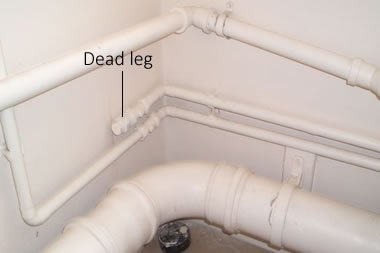Removing Dead Legs from Hot & Cold Water Pipes to Prevent Legionella

Dead legs may sound like something you get after sitting for too long, but when they are found in water systems they can present a significant risk to people as they encourage the stagnation of water and the growth of potentially dangerous bacteria such as legionella.
The term dead leg, or dead end is typically used to describe a run of pipework that is no longer in use or a pipe that has become isolated from the regular flow of water.
The term can also refer to a run of pipework that is only used very occasionally. In such instances, this lack of use can lead to water stagnation and increase the risk that the water inside the pipe becomes contaminated with potentially dangerous bacteria, including legionella.
This contamination can lead to problems within the rest of the water system and should be avoided.
Is removing dead legs from your water pipes a good idea?
If you know a length of pipework forming part of your hot or cold water distribution system is never used, or has become isolated then steps should be taken to remove it entirely, rather than simply capping it off.
Capping it will simply lead to stagnant water collecting inside the pipe.
This in turn leads to a greater chance for bacteria to multiply in that water, including the Legionella bacterium.
This can in-turn lead to Legionnaires’ disease and Pontiac fever, a less harmful yet still problematic condition stemming from legionella bacterial contamination.
… as a rule of thumb the maximum size of a dead pipe or dead leg should be no longer than 1.5 x its width
As a rule of thumb, and according to guidelines, the maximum size of a dead pipe or dead leg should be no longer than 1.5 x its width.
If you are unsure about removing dead legs safely and to ensure they are done properly, you can hire an expert familiar in dealing with such pipework.
What if the water pipe is used only occasionally and cannot therefore be removed?
While this scenario is not ideal, if it cannot be avoided you should consider how you can make the dead leg less dangerous if it needs to be retained within the water system.
The most obvious way to do this is to flush the pipes through periodically.
This makes it harder for any bacteria to remain, and ensures the system is safer than it would otherwise be.
Review your legionella risk assessment
If you are the designated responsible person, responsible for the upkeep of a hot or cold water system, you should have a legionella risk assessment and risk management procedures in place.
This report should account for all dead legs in the system.
Those that cannot be removed under the conditions stated above should be regularly reviewed to ensure the proper steps are taken to reduce risk factors.
Proper treatment of the hot and cold system will also reduce the risk.
It is also recommended that you consider hiring an expert company like Legionella Control International to carry out a full legionella risk assessment of your water systems, to ensure nothing is missed.
Only a fully-trained specialist will understand the complexities of the system to ensure the dangers of legionella and other bacteria are properly considered.
Legionella and water safety specialists
Our teams of water safety specialists support those responsible for the control of waterborne pathogens including Legionella bacteria across all regions of the UK and internationally.
We deliver professional water safety solutions, water testing, independent compliance auditing, City & Guilds training and other environmental risk management services that help keep people safe.
If you have questions about any of the issues raised above or you would like to speak with one of our legionella specialists please call us today on 0330 223 36 87 or contact us here.


